abbreviations: I have taken to using Jay Finley Christ’s four-letter abbreviations to refer to the books and stories in the Canon.
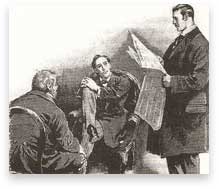 agony column: Holmes often turns to the agony column — ENGR: “Sherlock Holmes was, as I expected, lounging about his sitting-room in his dressing-gown, reading the agony column of The Times and smoking his before-breakfast pipe” — for clues or to lay a trap for a suspect or gather information. The agony column was the classified advertisement section of a newspaper where family members appealed for a wayward child to come home or the destitute appealed for money or criminals maintained private communications through cryptic messages.
agony column: Holmes often turns to the agony column — ENGR: “Sherlock Holmes was, as I expected, lounging about his sitting-room in his dressing-gown, reading the agony column of The Times and smoking his before-breakfast pipe” — for clues or to lay a trap for a suspect or gather information. The agony column was the classified advertisement section of a newspaper where family members appealed for a wayward child to come home or the destitute appealed for money or criminals maintained private communications through cryptic messages.
baritsu: the martial art in which Sherlock Holmes claimed proficiency, and with which he defeated Professor Moriarty at Reichenbach Falls. There is no martial art called baritsu, although a martial arts style called bartitsu reportedly existed at the time of Holmes.
Bertillon: Alphonse Bertillon created the science of anthropometry as a means to identify criminals, using physical measurements and photographs. He also pioneered many forensic innovations such as preserving footprint impressions and crime scene photography. His methods for identifying suspects involved complicated measurements and was supplanted by fingerprint identification.
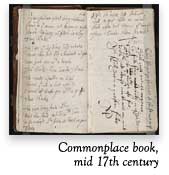 commonplace book: This is another one of those wonderful phrases like my particular friend. A commonplace book is simply a scrapbook and Holmes must have filled dozens, maybe hundreds of them. Remember at this time you couldn’t just bookmark something on the internet. If you wanted to later refer to a newspaper article, you clipped it out and pasted it into a book.
commonplace book: This is another one of those wonderful phrases like my particular friend. A commonplace book is simply a scrapbook and Holmes must have filled dozens, maybe hundreds of them. Remember at this time you couldn’t just bookmark something on the internet. If you wanted to later refer to a newspaper article, you clipped it out and pasted it into a book.
COPP: “Just look up the trains in Bradshaw”: (George) Bradshaw’s Railway Companion, begun in 1839, were railway time tables (Britain had many competing railways companies) that were indispensible in confirming or refuting alibis and are mentioned several times in the Canon. The company also published guides and maps and even air travel guides. The last guide was printed in 1961.
the Canon: collectively the four novels and 56 short stories featuring Sherlock Holmes written by Sir Arthur Conan Doyle. Saying something is not canon means that it is not in the Canon (for instance the quote, “Elementary, my dear Watson”).

constitutional monarchy: England is a constiutional monarchy, that is the king or queen is a largely ceremonial position and acts as the head of state. The monarch can grant honors and formally appoints the prime minister (and in a hung parliament, could theoretically select the prime minister) and fomally summons and dissolves parliament. Documents such as the Magna Carta in 1215 and the English Bill of Rights in 1689 gradually reduced the monarch’s power. The monarch has certain “prerogatives” that have largely gone unexercised in modern times.
Incidentally, there is no such thing as the British constitution. It is mixture of common law and those documents mentioned previously that collectively are a de facto constitution.
coroner’s inquest or jury: you’ll see mention again and again in Holmes, Poirot and Miss Marple stories about an inquest being held after Lord Thingummy is found dead in his locked study with a frozen look of horror on his face. A coroner called the inquest to determine the nature and cause of death and whether foul play is involved, and if so, refer the case to court, usually the Assizes (periodic criminal courts). Until 1924, a jury ruled on the evidence. Increasingly, coroners are now medical examiners, but at the times of Austen and even Holmes, coroners were rarely medical doctors.
irregulars: The Baker Street Irregulars is both the name of the principal Sherlock Holmes society and the street urchins Holmes employed.
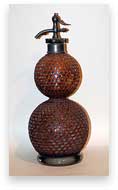 gasogene: A device that made carbonated water for alcoholic drinks. A chemical reaction in the upper chamber forced carbon dioxide in the lower chamber, mixed with water and was delivered through the spout. They sometimes exploded (notice the mesh covering the glass).
gasogene: A device that made carbonated water for alcoholic drinks. A chemical reaction in the upper chamber forced carbon dioxide in the lower chamber, mixed with water and was delivered through the spout. They sometimes exploded (notice the mesh covering the glass).
Another liquor related object is the tantalus, which is a contraption that can lock liquor decanters (bottles). Unfortunately, Sherlockians are divided whether the tantalus is Canon.
Gasogene is also a term used to refer to the leader and organizer of a scion society.
 hackney, hansom, growler: a two-wheeled carriage drawn by a single horse and used as a taxi cab and refers to either originally a brougham and later a Hansom safety cab. The carriage might also be called a growler. As Holmes observes in STUD: “The ordinary London growler is considerably less wide than a gentleman's brougham.”
hackney, hansom, growler: a two-wheeled carriage drawn by a single horse and used as a taxi cab and refers to either originally a brougham and later a Hansom safety cab. The carriage might also be called a growler. As Holmes observes in STUD: “The ordinary London growler is considerably less wide than a gentleman's brougham.”
pastiche: a novel written in the style of an author and usually borrowing an author’s characters, like Sherlock Holmes and John Watson. It has a long tradition in the Sherlockian world, from August Derleth’s Solar Pons to John Dickson Carr’s and Adrian Conan Doyle’s collaboration The Exploits of Sherlock Holmes to the current Death Cloud, which explores the adventures of a 14-year-old Holmes.
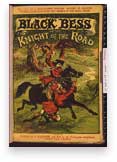 penny dreadfuls: Also called penny horribles and penny awfuls, these were cheap and usually lurid stories that were popular in the 19th century, the pulp fiction of their day. The stories featured character such as highwayman Dick Turpin and Sweeney Todd, the demon barber.
penny dreadfuls: Also called penny horribles and penny awfuls, these were cheap and usually lurid stories that were popular in the 19th century, the pulp fiction of their day. The stories featured character such as highwayman Dick Turpin and Sweeney Todd, the demon barber.
playing the game, the Grand Game: maintaining the belief that Sherlock Holmes was a real person, that his biographer was John Watson and that Arthur Conan Doyle was merely Watson’s literary agent. Wait, that’s not true?
scion society: scion societies are organizations of Holmes enthusiasts (Sherlockians) sanctioned by the Baker Street Irregulars, a notoriously exclusive organization (you can’t join, you have to be invited, usually after another member has been found dead in the library with a dagger of oriental design protruding from his back).
 Scotland Yard, London Metropolitan Police: Also known as Scotland Yard, the Metropolitan Police serve greater London (with the exception of the original square mile, served by the City of London Police). It was founded in 1829 by Sir Robert Peel, whence the nicknames bobbies and peelers. It’s headquarters, Scotland Yard, is so named for its location where the kings of Scotland resided while in London, although the headquarters have moved three times, with both the second and third locations being called “New Scotland Yard.” To my knowledge, its jurisdiction does not extend beyond the metropolitan area, although in Holmes’ time, local police would gladly request the help of Scotland Yard.
Scotland Yard, London Metropolitan Police: Also known as Scotland Yard, the Metropolitan Police serve greater London (with the exception of the original square mile, served by the City of London Police). It was founded in 1829 by Sir Robert Peel, whence the nicknames bobbies and peelers. It’s headquarters, Scotland Yard, is so named for its location where the kings of Scotland resided while in London, although the headquarters have moved three times, with both the second and third locations being called “New Scotland Yard.” To my knowledge, its jurisdiction does not extend beyond the metropolitan area, although in Holmes’ time, local police would gladly request the help of Scotland Yard.
the telegraph/telephone: With the sum total of human knowledge residing on our smart phones, it’s easy to think of the Victorian age as primitive, but the information age was born during this period with the:
- post (12 deliveries a day)
- telegraph (SIGN: “He telegraphed to me from London that he had arrived all safe”)
- telephone (SIGN: “I can step across the road and telephone to make sure”)
- the Underground (REDH: “We travelled by the Underground as far as Aldersgate”)
- and the competing railway companies (COPP: “ ‘There is a train at half-past nine,’ said I, glancing over my Bradshaw”)
One has to imagine that to the Victorians their age was as fully at the forefront of modern technology as is ours. Some have argued that the impact of the telegraph exceeds that of the internet.
tobacco: one cannot underestimate the role tobacco and smoking plays in the Canon. Here are a few examples:
- A three-pipe problem is one so vexing Holmes must smoke three bowlfuls — REDH: “It is quite a three pipe problem, and I beg that you won't speak to me for fifty minutes.”
- His love of strong tobacco — HOTB: “When you pass Bradley’s, would you ask him to send up a pound of the strongest shag tobacco?”)
- His monograph on cigarette ashes — SIGN: Upon the Distinction between the Ashes of the Various Tobaccoes — “In it I enumerate a hundred and forty forms of cigar-, cigarette-, and pipe-tobacco, with colored plates illustrating the difference in the ash.”
- The Persian slipper in which he keeps his tobacco
- His meerschaum pipe (note this is intentially misleading so please follow the link).
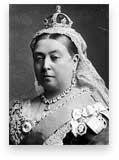 Victorian: As Jane Austen is the Regency era, Holmes is the Victorian era, defined by the reign of Queen Victoria from 1837 to 1901. Her father was Prince Edward, Duke of Kent and Strathearn, the fourth son of King George III, and she became queen after the death of her uncle, King William IV. Her reign saw rapid industrialization in England and labor unrest (she escaped several assassination attempts) and the enlargement of the British empire (she became Empress of India in 1876).
Victorian: As Jane Austen is the Regency era, Holmes is the Victorian era, defined by the reign of Queen Victoria from 1837 to 1901. Her father was Prince Edward, Duke of Kent and Strathearn, the fourth son of King George III, and she became queen after the death of her uncle, King William IV. Her reign saw rapid industrialization in England and labor unrest (she escaped several assassination attempts) and the enlargement of the British empire (she became Empress of India in 1876).
